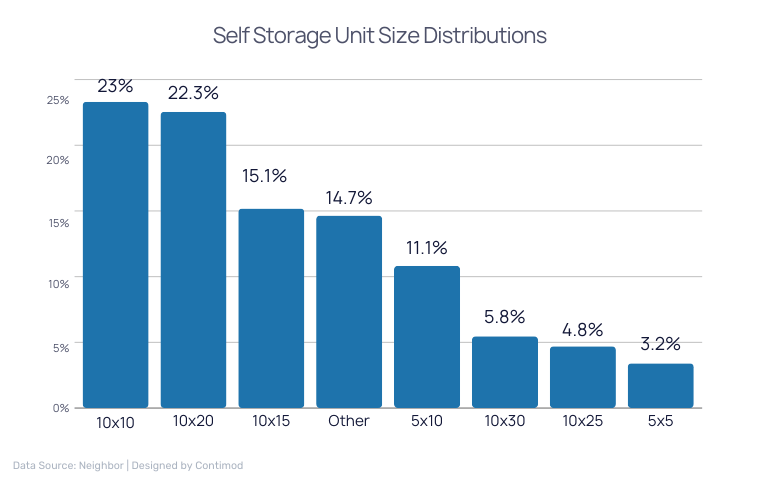35+ Self-Storage Statistics: A Must Know in 2024
Self-storage has become an essential part of modern life for many individuals and families who need extra space for their belongings due to moving downsizing or simply accumulating too many items.
But just how widespread is self-storage today?
With that in mind, we’ll cover self-storage statistics that reveal the current trends in self-storage usage.
Self-Storage Statistics: Key Numbers
- There are 52,301 total self-storage facilities in the U.S.
- 14.5 million households currently utilize self-storage services.
- The self-storage market reached $44.3 billion in 2024 and is expected to reach $50 billion by 2029.
- 40% of people cited not having enough space at home as the primary reason for turning to self-storage.
- 71% of self-storage properties are managed by independent (mom & pop) operators.
- Only ~20% of the market is controlled by the top six publicly-traded self-storage companies.
Sources: (SeekingAlpha, StorageCafe, Radius+, The 2023 Self Storage Demand Study by the Self Storage Association (SSA), CRE Advisory)
How many Americans Use Self-Storage?
According to a study by StorageCafé, an impressive 38% of Americans utilize self-storage facilities.

Self-storage has gained immense popularity, whether people are moving, downsizing, or simply need extra space for their belongings. It’s a convenient solution when there’s just too much stuff to keep at home.
Self-storage Market Share
The self-storage market share distribution provides valuable insight into the major players dominating the sector. The following statistics outline the competitive share held by key companies and highlight industry dominance:
- Non-REIT properties: 80%
- Public Storage: 5.5%.
- Extra Space Storage: 3.9%.
- U-Haul: 3.6%.
- CubeSmart: 2.5%.

Source: SeekingAlpha
Self-storage Vacancy Rate
The changes in self-storage vacancy rates reveal how supply and demand have evolved in recent years. To better understand these trends, take a closer look at how they develop:
| Year | Vacancy Rate (%) |
|---|---|
| 2015 | 9.2 |
| 2016 | 9.3 |
| 2017 | 9.6 |
| 2018 | 9.8 |
| 2019 | 9.5 |
| 2020 | 7.2 |
| 2021 | 6.6 |
| 2022 | 8.7 |
| 2023 | 9.6 |
| 2024* | 9.6 |
Source: Statista
Self Storage Use by Generations
Each generation has distinct patterns in self-storage usage now and going forward. Find out how different age groups utilize self-storage:
| Generation | Currently Using (%) | Plan to Use in the Future (%) |
|---|---|---|
| Gen Zers | 14% | 18% |
| Millennials | 30% | 17% |
| Gen Xers | 44% | 21% |
| Baby Boomers | 38% | 10% |
| Silent Generation | 27% | 14% |
Source: RentCafe

Self Storage Use by Home Size
Storage units come in multiple sizes yet certain dimensions are favored by most users. Here is a summary of the unit sizes that are most commonly used:

| Home Size | Using (%) | Plan to Use in the Future (%) |
|---|---|---|
| Under 1,000 sq. ft. | 23% | 13% |
| 1,000 to 1,499 sq. ft. | 25% | 14% |
| 1,500 to 2,499 sq. ft. | 28% | 14% |
| 2,500 to 3,500 sq. ft. | 27% | 12% |
| Over 3,500 sq. ft. | 17% | 16% |
Source: RentCafe analysis of online survey data.
Reasons to Use Self-Storage
Self-storage has become a go-to solution for everything from space issues to life changes. Here’s why more people are turning to self-storage:

| Reason | Percentage (%) |
| Not enough space at home | 40% |
| Moving (other than downsizing) | 34% |
| Downsizing your home | 8% |
| Changes in household size | 7% |
| Storing for business purposes | 5% |
| Home renovation | 3% |
| Other | 2% |
Source: StorageCafe analysis of online survey data.
Self Storage Unit Size Distributions
Self-storage units come in a wide range of sizes, with varying levels of popularity among customers. Here’s a breakdown of the most common unit sizes and their distribution:

| Unit Size | Percentage (%) |
|---|---|
| 10×10 | 23.0% |
| 10×20 | 22.3% |
| 10×15 | 15.1% |
| Other | 14.7% |
| 5×10 | 11.1% |
| 10×30 | 5.8% |
| 10×25 | 4.8% |
| 5×5 | 3.2% |
Source: Neighbor
We hope you like this self-storage resource page. By the way, if you own a house and are looking to buy storage containers to store your stuff, then Contimod can help you find storage suppliers that serve your area.